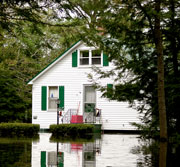 |
 |
 |
|
Coverage Concerns Floods "outside the box" Torrential rains in areas outside flood zones spark interest in flood policies By Roy C. McCormick Insurance agents, brokers, counselors and companies face two distinct challenges (and opportunities) regarding the flood problem brought on by ongoing weather conditions. The first involves adjustment questions and problems following coastal hurricanes and other waterway damage; the other, inland flooding from continuous torrential rain. For example, Tropical Storm Ernesto, which passed through the Carolinas and into Virginia on Labor Day weekend this year, underscores the adjustment difficulties that emerge as a result of the combination of high wind and water surge from a body of water. Second, heavy rain throughout the country has pointed out the widespread need for flood insurance in areas nowhere near bodies of water, places where the exposure and insurance protection have not generally been considered and discussed. The initial step is to become aware of the conditions cited in both homeowners and commercial property policies—which are similar in both. This article will focus on homeowners policies because of their widespread use and because many insureds have limited knowledge of the exposure. The language may vary from company to company but the intent is similar. There is no coverage for damage caused by flood, surface water, waves, tides, tidal waves, overflow of a body of water, or spray from any of these, whether driven by wind or not. Mudslide and mudflow are specifically excluded in some forms for clarification, although they are otherwise considered within the scope of the exclusion. The exposure is picked up under National Flood Insurance by insuring direct damage to covered property caused by flooding. “Flood” is defined in the National Flood Insurance Program as “a general and temporary condition during which the surface of normally dry land is partially or completely inundated.” It is a condition of coverage that at least two properties in the area or two or more acres must be affected. Flooding can be caused by: • Overflow of inland or tidal waters • Unusual or rapid accumulation or runoff of surface waters from any source, such as heavy rainfall • Mudslides, meaning mudflows caused by flooding that could be rivers of liquid and flowing mud • Collapse or destabilization of land along the shore of a lake or other body of water resulting from erosion or the effect of waves, or water currents exceeding normal cyclical levels Challenge and opportunity Two distinct challenges and opportunities lie ahead. When hurricanes occurred in areas where both the need for and the availability of flood insurance had been stressed for years, many property owners who suffered major losses claimed that they thought they were covered under their homeowners policies and that they never were informed about separate flood insurance. The other area of concern is the absence of flood coverage in the insurance programs in areas across the country that are not subject to storm surges on coasts or sharp increases in the water level of inland lakes and rivers. Many of these areas recently have been deluged with heavy continuous rain. Accumulation of water in low areas often results in property losses as damaging as those caused by coastal storm surges. The National Flood Insurance Program has developed preferred risk policies that provide coverage for properties in those areas, and those in coastal areas with moderate risk. The premiums are attractive. Flooding is the most common natural disaster. Over 60% of all presidentially declared disasters in recent years included flooding. Between 20% and 25% of the National Flood Insurance Program’s claims came from outside high flood risk areas. Obviously, property owners must be informed about the exposure that it is not covered by their basic property insurance, and that flood coverage under the NFIP is available for their structures and general personal property. Buyers of homeowners policies, whether or not they carry flood insurance on general property, may supplement their protection with insurance on a schedule basis for especially valuable classes or objects of personal property. Although subject to a limited number of reasonable exclusions, the forms clearly cover damage by surface water and flooding. High value oriental rugs, for example, are frequently displayed on first-floor levels and are vulnerable to water damage. As the protection is on an “all-risks” except as specifically excluded basis, it is important to include valuable objects such as paintings and the like that could fall or be punctured accidentally. Countrywide deluges also have brought about unprecedented water damage to private passenger automobiles and commercial vehicles. The flood peril is covered under comprehensive coverage (aka “other than collision coverage” in many personal auto forms) of automobile policies. In lieu of comprehensive coverage, protection for the flood peril may be made effective for a commercial vehicle under a specified causes of loss form. People with mortgages in flood zones that are rated high risk carry flood insurance as a condition of the loan. Sadly, too many drop it when the loan is satisfied and the potential loss to property becomes totally theirs. The National Flood Insurance Program (NFIP) and insurance organizations are currently addressing the problem with television and newspaper alerts designed to convince property owners in flood zones to carry the insurance. The NFIP also has developed a series of lower cost flood policies for dwelling owners, renters, businesses and other properties located outside high-risk flood zones. * The author |
|
|||||||||||||
| ||||||||||||||
